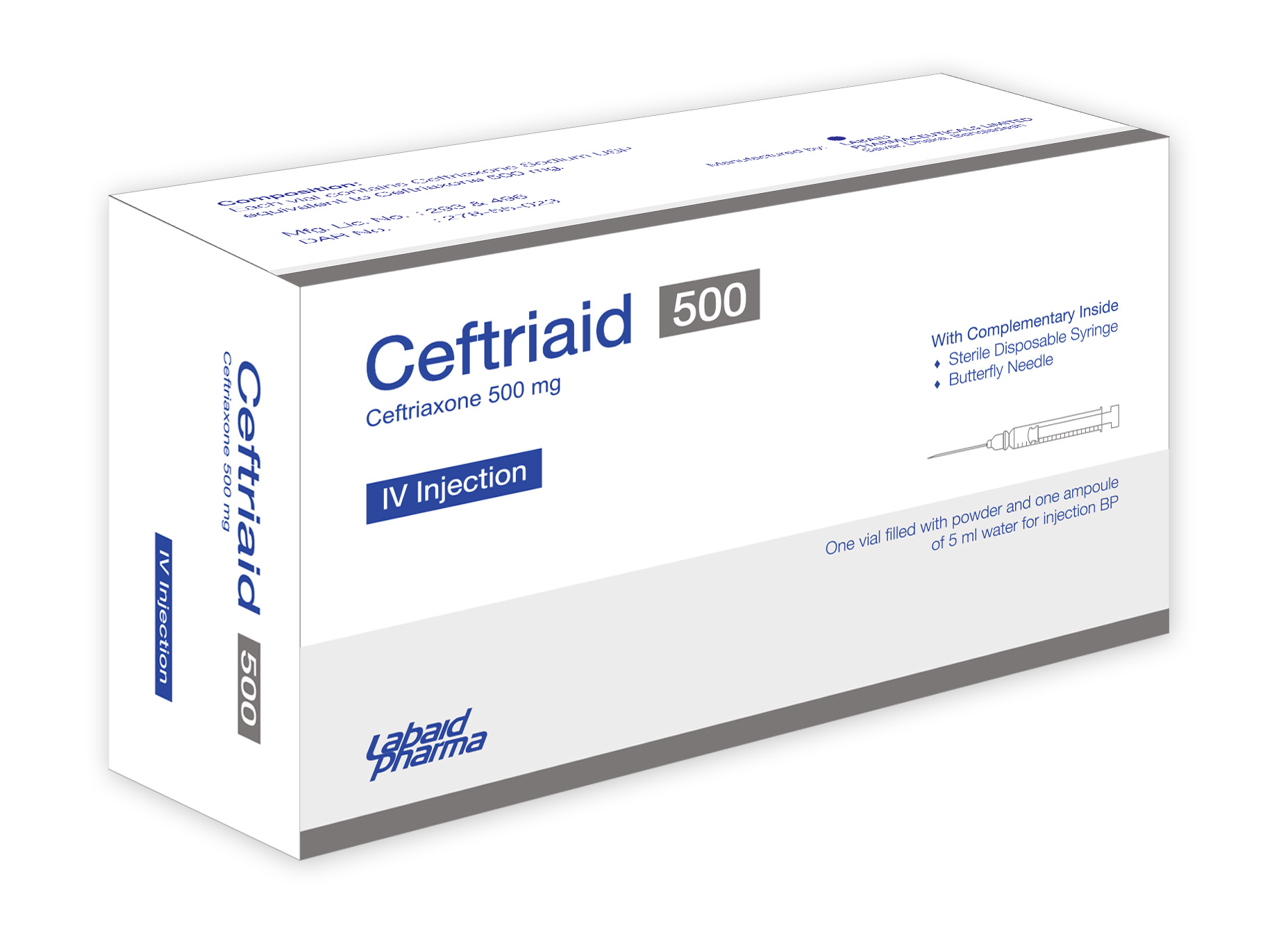Ceftriaid 500 mg IV Injection

Generic : Ceftriaxone
Therapeutic : Ceftriaxone
Description :
Ceftriaid (Ceftriaxone) is a third generation broad spectrum parenteral cephalosporin antibiotic. Ceftriaid interferes with the synthesis of bacterial cell wall by inhibiting transpeptidase enzyme. As a result the bacterial cell wall is weakened, the cell swells and then ruptures.
Indications :
Ceftriaid is indicated for the treatment of the following major infections when caused by susceptible organisms: Renal and urinary tract infections, lower respiratory tract infections, particularly pneumonia, gonococcal infections, skin and soft tissue infections, bone and joint infections, bacterial meningitis, serious bacterial infections e.g. septicemia, ENT infections, infections in cancer patients, prevention of postoperative infection, perioperative prophylaxis of infections associated with surgery & typhoid fever.
Dosage & Administration :
Ceftriaid (Ceftriaxone) can be administered either intravenously or intramuscularly. Adults: The usual adult daily dose is 1-2 g once daily (or twice daily in equally divided doses), depending on the type and severity of infection. The daily dose may be increased, but should not exceed 4 g. For preoperative use (surgical prophylaxis), a single dose of 1 gm administered intravenously 0.5-2 hours before surgery is recommended. In elderly patients, the dosages do not require modification provided that renal and hepatic functions are satisfactory. In patients with impaired renal function, there is no need to reduce the dosage of Ceftriaid provided liver function is intact. In patients with liver damage, there is no need for the dosage to be reduced provided renal function is intact.
Gonorrhea: For the treatment of gonorrhea (penicillinase producing and non-penicillinase producing strains), a single intramuscular dose of 250 mg is recommended.
Children under 12 years: The recommended total daily dose is 50 to 75 mg/kg once daily (or twice daily in equally divided doses). In severe infections, up to 80 mg/kg body weight daily may be given. The total daily dose should not exceed 2 gm. In the treatment of meningitis, the initial dose of 100 mg/kg body weight (not to exceed 4 gm daily) once daily (or twice daily in equally divided doses) is recommended. As soon as the causative organism has been identified and its sensitivity, the doses can be reduced accordingly. The usual duration of therapy in meningitis is 7 to 14 days.
Side Effects :
Ceftriaid is generally well tolerated. A few side-effects such as 1. Gastrointestinal effects include diarrhea, nausea and vomiting, stomatitis and glossitis 2. Cutaneous reactions include rash, pruritus, urticaria, edema & erythema multiforme 3. Hematological reactions include eosinophilia, thrombocytosis, leukopenia and neutropenia 4. Hepatic reactions include elevations of SGOT or SGPT, bilirubinemia 5. CNS reactions include headache, hyperactivity, nervousness, sleep disturbances, confusion, hypertonia and dizziness were reported. Local phlebitis occurs rarely following intravenous administration but can be minimized by slow injections over 2-4 minutes.
Use in Special Group:
Pregnancy: The safety of Ceftriaxone in the treatment of infections during pregnancy has not been established. Ceftriaxone should only be used during pregnancy if the likely benefit outweighs the potential risk to the fetus and/or the mother.
Lactation: Ceftriaxone is excreted in breast milk at low concentrations. Therefore, caution should be exercised when Ceftriaxone is administered to a nursing mother.
Contraindications:
Ceftriaid should not be given to patients with a history of hypersensitivity to cephalosporin antibiotics. It is contraindicated in premature infants during the first 6 weeks of life. Its safety in human pregnancy has not been established. Ceftriaxone is contraindicated in neonates if they require (or are expected to require) treatment with calcium-containing IV solutions, including continuous calcium-containing infusions such as parenteral nutrition because of the risk of precipitation of Ceftriaxone-calcium.
Precautions:
Ceftriaxone should be administered with caution to individuals with a history of gastrointestinal disease, particularly colitis.
Drug Interaction :
Potentially hazardous interactions: No impairment of renal function or increased nephrotoxicity has been observed in man after simultaneous administration of Ceftriaxone with diuretics, or with aminoglycosides. A possible disulfiram-like reaction may occur with alcohol. Other significant interactions: Ceftriaid does not interfere with the protein binding of bilirubin. Simultaneous administration of Probenecid does not alter the elimination of Ceftriaxone.
Storage :
Keep away from light, moisture and store below 250 C. Keep out of the reach children.
Commercial Pack:
Ceftriaid 500 mg IV Injection: Each combipack contains 1 vial of Ceftriaxone 500 mg as Ceftriaxone Sodium USP with 1 ampoule of 5 ml water for injection BP, sterile disposable syringe (5 ml) and butterfly needle.
Ceftriaid 1 gm IV Injection: Each combipack contains 1 vial of Ceftriaxone 1 gm as Ceftriaxone Sodium USP with 1 ampoule of 10 ml water for injection BP, sterile disposable syringe (10 ml), butterfly needle, first aid bandage and alcohol pad.
Ceftriaid 2 gm IV Injection: Each combipack contains 1 vial of Ceftriaxone 2 gm as Ceftriaxone Sodium USP with 2 ampoules of 10 ml water for injection BP, sterile disposable syringe (20 ml), butterfly needle, first aid bandage and alcohol pad.
Download Product Manual
Back


